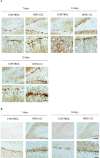Glycogen synthase kinase 3 inhibition promotes adult hippocampal neurogenesis in vitro and in vivo
- PMID: 23173075
- PMCID: PMC3503340
- DOI: 10.1021/cn300110c
Glycogen synthase kinase 3 inhibition promotes adult hippocampal neurogenesis in vitro and in vivo
Abstract
Glycogen synthase kinase-3 (GSK-3) is a serine/threonine kinase originally identified as a regulator of glycogen metabolism but it also plays a pivotal role in numerous cellular functions, including differentiation, cell cycle regulation, and proliferation. The dentate gyrus of the hippocampus, together with the subventricular zone of the lateral ventricles, is one of the regions in which neurogenesis takes place in the adult brain. Here, using a chemical genetic approach that involves the use of several diverse inhibitors of GSK-3 as pharmacological tools, we show that inhibition of GSK-3 induces proliferation, migration, and differentiation of neural stem cells toward a neuronal phenotype in in vitro studies. Also, we demonstrate that inhibition of GSK-3 with the small molecule NP03112, called tideglusib, induces neurogenesis in the dentate gyrus of the hippocampus of adult rats. Taken together, our results suggest that GSK-3 should be considered as a new target molecule for modulating the production and integration of new neurons in the hippocampus as a treatment for neurodegenerative diseases or brain injury and, consequently, its inhibitors may represent new potential therapeutic drugs in neuroregenerative medicine.
Figures






References
-
- Gage F. H. (2000) Mammalian neural stem cells. Science 287, 1433–1438. - PubMed
-
- Gage F. H.; Kempermann G.; Palmer T. D.; Peterson D. A.; Ray J. (1998) Multipotent progenitor cells in the adult dentate gyrus. J. Neurobiol. 36, 249–266. - PubMed
-
- Eriksson P. S.; Perfilieva E.; Bjork-Eriksson T.; Alborn A. M.; Nordborg C.; Peterson D. A.; Gage F. H. (1998) Neurogenesis in the adult human hippocampus. Nat. Med. 4, 1313–1317. - PubMed
-
- Kee N.; Teixeira C. M.; Wang A. H.; Frankland P. W. (2007) Preferential incorporation of adult-generated granule cells into spatial memory networks in the dentate gyrus. Nat. Neurosci. 10, 355–362. - PubMed
Publication types
MeSH terms
Substances
LinkOut - more resources
Full Text Sources
Other Literature Sources

